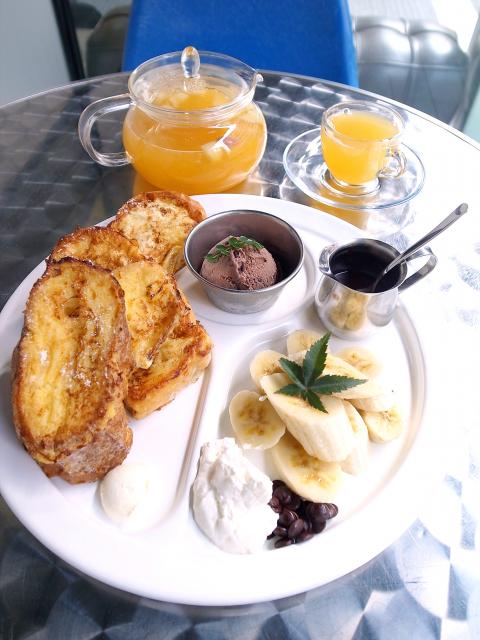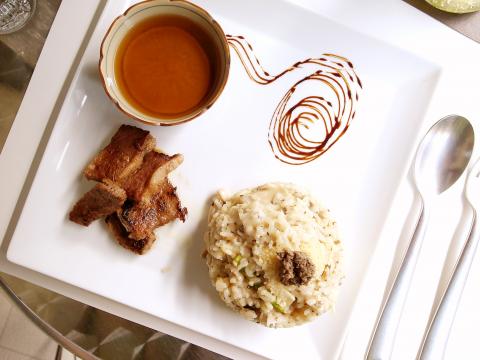Admittedly, a sleek cafe serving decorative waffles and sundaes in Taipei usually conjures up the image of snap-happy female customers in cutesy outfits. But those who feel acutely alienated from the kawaii mentality should have no difficulty dining at Wednesday Cafe. While frilly confections make up the bulk of its dessert menu, the establishment attracts a different demography with display cases filled with collectible toys and figures along with its reputation as a work of Wonderwall, a Japanese interior design firm founded by celebrated designer Masamichi Katayama and responsible for such creations as the BAPE, Uniqlo and Dean and Deluca stores in Japan.
Located on the boutique store-lined Daan Road (大安路), the cafe is hard to miss, greeting passersby with its fashionably promising, black-and-white storefront. Step inside and one is immediately lured by an array of toys, accessories and gismos for sale, including a necklace made of the head of a Barbie Doll.
The attraction continues in the spacious dining area, strewn with toy collectibles. Fans of Star Wars, The Simpsons, Batman and other American superheroes are likely to salivate at the extensive collection on display. In the back of the room, a pinball machine stands next to a DJ booth surrounded by more collectibles. Nearby, impeccably attired young chefs are seen minding the kitchen which is separated from the diners by large, spotless glass window.

Photos: Ho Yi, Taipei Times
The interior design, however, is rather disappointingly kept understated as if the purpose of the design is to direct all the attention to the cafe’s prized collection, composed of not only Americana toys but the timeless fiberglass chairs created by the legendary American designer couple Charles and Ray Eames in the 1950s. Consequently, it is not surprising that at the cafe, well-informed clienteles always choose chair seats over the lounge area.
Classics aside, Wednesday Cafe’s menu mostly belongs to the fusion genre. The savory options, in particular, show influences from the East and West. One example is the pan-fried short rib steak with truffle risotto (和風牛小排松露燉飯, NT$490). Mixed with mushrooms, asparagus and baby corns, the risotto comes with a small bowl of steamed white radish and a separate plate of thin-sliced steaks that were slightly overcooked.
For a local zest, Wednesday fried rice (Wednesday炒飯, NT$350) puts together a nostalgic flavor using lard, shallots and soy sauce. Chicken and bacon roll with sesame sauce (和風培根雞肉捲, NT$250) is a nicely balanced dish thanks to the sweetness of raisins and the aromatic sesame.

Photos: Ho Yi, Taipei Times
On the dessert section, the majority of the items involve either waffles or French toasts. The banana chocolate French toast (香蕉巧克力法式吐司, NT$250) I ordered is more than enough for two people and boasts chocolate ice cream, whipped cream, banana slices, butter and satisfyingly rich chocolate sauce. Other sweet choices include fruit sundae (水果聖代, NT$230), banana ice cream cake (冰淇淋芭娜娜, NT$180), blueberry waffle (藍莓鬆餅, NT$220) and earl grey tea-flavored pudding (布丁, NT$120).
The beverage menu sports an admirable selection of coffee and tea served either hot or cold including the Wednesday fruit tea (星期三水果茶, NT$220), hazelnut-flavored latte (榛果拿鐵, NT$195) and white gourd milk tea (冬瓜奶茶, NT$200). There is also a variety of milk shake (NT$220), smoothies (NT$220) and fruit milk (NT$220) to choose from. Health-conscious diners might want to check out the cafe’s special offering of fruit and vegetable juices (NT$240).
Wednesday Cafe also has a small patio seating area, which is not an entirely bad idea when the traffic is relatively slow on Daan Road. Service by the young waiting staff is adequate but offers no surprise.

April 14 to April 20 In March 1947, Sising Katadrepan urged the government to drop the “high mountain people” (高山族) designation for Indigenous Taiwanese and refer to them as “Taiwan people” (台灣族). He considered the term derogatory, arguing that it made them sound like animals. The Taiwan Provincial Government agreed to stop using the term, stating that Indigenous Taiwanese suffered all sorts of discrimination and oppression under the Japanese and were forced to live in the mountains as outsiders to society. Now, under the new regime, they would be seen as equals, thus they should be henceforth

Last week, the the National Immigration Agency (NIA) told the legislature that more than 10,000 naturalized Taiwanese citizens from the People’s Republic of China (PRC) risked having their citizenship revoked if they failed to provide proof that they had renounced their Chinese household registration within the next three months. Renunciation is required under the Act Governing Relations Between the People of the Taiwan Area and the Mainland Area (臺灣地區與大陸地區人民關係條例), as amended in 2004, though it was only a legal requirement after 2000. Prior to that, it had been only an administrative requirement since the Nationality Act (國籍法) was established in

Three big changes have transformed the landscape of Taiwan’s local patronage factions: Increasing Democratic Progressive Party (DPP) involvement, rising new factions and the Chinese Nationalist Party’s (KMT) significantly weakened control. GREEN FACTIONS It is said that “south of the Zhuoshui River (濁水溪), there is no blue-green divide,” meaning that from Yunlin County south there is no difference between KMT and DPP politicians. This is not always true, but there is more than a grain of truth to it. Traditionally, DPP factions are viewed as national entities, with their primary function to secure plum positions in the party and government. This is not unusual

US President Donald Trump’s bid to take back control of the Panama Canal has put his counterpart Jose Raul Mulino in a difficult position and revived fears in the Central American country that US military bases will return. After Trump vowed to reclaim the interoceanic waterway from Chinese influence, US Defense Secretary Pete Hegseth signed an agreement with the Mulino administration last week for the US to deploy troops in areas adjacent to the canal. For more than two decades, after handing over control of the strategically vital waterway to Panama in 1999 and dismantling the bases that protected it, Washington has